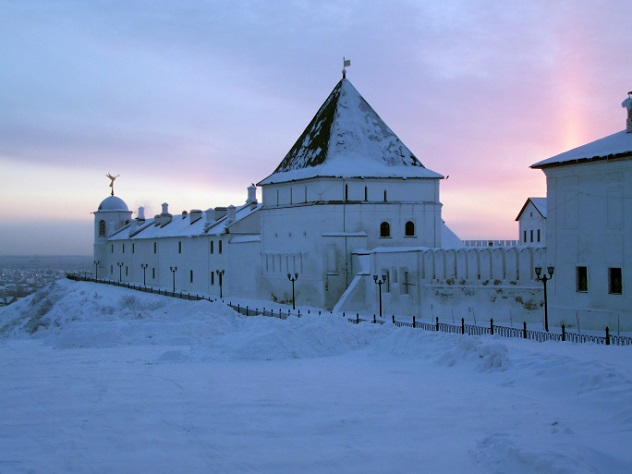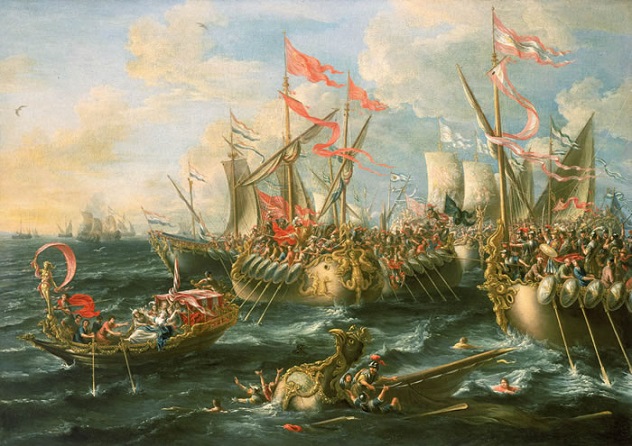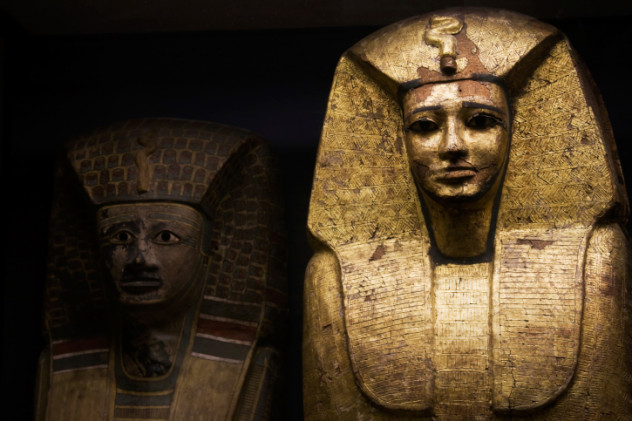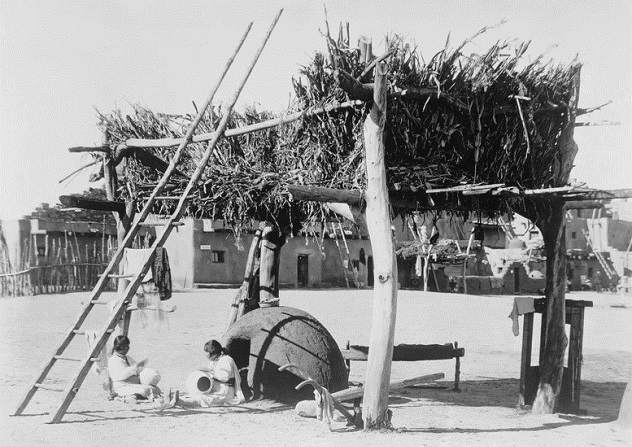10The Chinese
From 1368–1644, China was ruled by the Ming Dynasty. As Europe was becoming dominated by ships and sails, China was also encouraging naval exploration, and one expedition may have led to America. The theory—which has been dubbed the “1421 theory,” the year the Chinese supposedly made landfall—was popularized by British amateur historian Gavin Menzies, who noted similarities between Chinese and Native American culture. Menzies posits that during the 70 years before Columbus reached the New World, the Chinese were ruling major American tribes and interbreeding with the natives. There’s not much evidence to support the 1421 theory, but what does exist includes old Chinese coins that were found scattered throughout the Pacific Northwest, an old Nez Pierce garment made of Chinese beads, a Chinese horseman painted in a Colombian cave, and a Chinese jade found in California, all of which allegedly date back to before Columbus’s arrival. The most compelling evidence comes from a Chinese map that was supposedly drawn in 1408 and depicts the entire world, including the American supercontinent. Many historians have dismissed this map as a Chinese copy of a 17th-century Jesuit map, mostly because China itself is so poorly detailed. In the end, there’s no real way of confirming or dismissing the 1421 theory. The Qing Dynasty, which succeeded the Ming Dynasty, destroyed numerous Ming documents as a means of enforcing its rule.
9Semites
There are multiple theories that ancient Semitic peoples visited the Americas. One formerly popular theory suggests that the Phoenicians were responsible for establishing the major pre-Columbian Native American empires. This theory is heavily associated with the legend of Votan, a mythological figure who allegedly founded the first city of the New World in 1000 B.C. Curiously, this critically important figure is referenced only in European texts. Most of the archaeological evidence in support of the Phoenician theory has been dismissed as fake, but there is an intriguing Carthaginian coin that may feature a map of the world. The Carthaginians were descendants of the Phoenicians, so their knowledge of the New World would support the theory. A more widespread theory concerns the Israelites. According to the Book of Mormon, three Israelite groups—the Nephites, Lamanites, and Mulekites—settled the Americas with a non-Israelite group called the Jaredites. They established major cities, wrote extensively in Hebrew and Egyptian, and imported flora and fauna from the Old World. These groups together were also said to be the ancestors of the Native Americans. Nothing in archaeology or genetic testing has substantiated any of these claims, and none of the groups are mentioned outside of Latter-day Saints literature, but because the Book of Mormon is considered divine, many believers accept the claims as fact.
8Siberians
If the Native Americans aren’t the descendants of the Israelites, where did they come from? Popular scientific opinion points to East Asia, specifically Siberia. According to the theory, prehistoric peoples from Siberia migrated to northern North America and gradually proliferated throughout the entire supercontinent. The migration is believed to have taken place around 11,000 years ago, but some archaeological evidence places that number as far back as 20,000–30,000 years ago. It’s widely believed that the Siberians traveled to America across the frozen Bering Strait during an ice age, but they also may have crossed the Bering Strait by boat. Though many aspects of the journey remain a mystery, this theory has been supported by genetic testing. In 2012, a team of anthropologists from the University of Pennsylvania released a study that showed a unique shared mutation between the southern Altai people of Siberia and Native Americans. It seems conclusive that credit for “discovering” America should go to these Siberians—not only did they beat Columbus, they were the first humans on the supercontinent, period.
7The Knights Templar
The Knights Templar were dissolved in the 14th century on charges of heresy, though many historians believe the real reason for the persecution was jealousy. Thanks to their banking system, the order of warrior monks was remarkably well off. Of course, being burned at the stake does tend to put a damper on business. During the fight against persecution, some knights supposedly escaped to Scotland, where they received help from Henry Sinclair, Prince of Orkney Islands. In 1393, Sinclair had carried out a survey of Greenland through a Venetian admiral. Now, in 1398, he was ready to lead an expedition to the New World by following old Viking routes. Twelve ships carried Sinclair and hundreds of Templar refugees to Nova Scotia, Canada, where the knights allegedly hid their treasure. Sinclair is then said to have explored as far south as present-day Massachusetts. Sinclair and the refugees may have assimilated with the natives instead of returning to Scotland. One outlandish claim is that the alleged gnostic beliefs of the Templar had a massive influence on Native American religion, while another states that the founding fathers were influenced by Templar teachings. The cited evidence includes a portrait of a medieval knight on a stone in Westford, Massachusetts and an old tower in Newport, Rhode Island that looks fairly European. The remains of an old castle, a cannon, and a stone wall in Nova Scotia are supposedly further evidence of the theory.
6Malians
The empire of Mali was a West African superpower in the late Middle Ages. Mali was stupendously wealthy, and its leader, Mansa Musa, was the richest man of all time. So mighty was his economic power that when he visited Egypt in 1324, he crashed the Egyptian gold market. While he was wreaking financial havoc on Egypt, Musa also told the story of his predecessor, Mansa Abubakari II. Abubakari had supposedly commissioned a voyage to the end of the Atlantic Ocean. He sent a fleet of 200 ships across the Atlantic, and after a lengthy waiting period, only one returned. Its sailors told Abubakari about a giant whirlpool that had swallowed the other ships. Abubakari was intrigued. He more or less abdicated the throne, then he assembled an absolutely monstrous fleet of 2,000 ships and set sail. He and his fleet never returned, and some speculated that he landed in Brazil in 1312. When Columbus arrived over 100 years later, he allegedly encountered African traders and spears tipped in African gold. The giant stone carvings of heads found in southern Mexico, called the Olmec Heads, have also been cited as evidence of Africans in pre-Columbian America. The Olmec are regarded as one of the first civilizations in Mexico, preceding other Mesoamerican empires, and their stone heads display decidedly African features.
5Romans
In 1933, archaeologists stumbled upon a genuine miniature Roman bust on a dig in Mexico. How or why it was there has yet to be fully explained, but the bust seems to predate the arrival of Cortes, eliminating the possibility that the Spanish brought it with them on an expedition. Roman coins have also been found at several dig sites in the United States, and in Rome, inexplicable images of pineapples have shown up in ancient art. The Romans may have learned how to navigate the oceans from the ancient Greeks. Many Greek city-states, like Athens, excelled in seafaring, and the Greeks knew that the world was round. Italian physicist Lucio Russo has suggested that a map by Ptolemy includes the Antilles, and Greek-Canadian scientist Dr. Minas Tsikritsis has suggested that a document by Plutarch describes in detail a journey from Carthage to Canada in A.D. 86. The Carthage-Canada journey was not just a one-time thing, according to Tsikritsis. Greeks (and Carthaginians) visited Canada as part of a Cronus worship ritual and to get some sweet copper from Lake Superior and Royale Island. About 50,000 tons of copper may have been mined from these areas between 2400 and 1200 B.C.
4Ancient Egyptians
In the early ’90s, scientists became puzzled by several Egyptian mummies, including pharaoh Ramesses II, that were found with trace amounts of nicotine and cocaine, which are native to the New World. This was likely a case of contamination, but it could also mean that the Egyptians got around more than we realized. After all, the similarities between Egyptian and Mesoamerican culture have long been noted. However, despite these links, there’s been little to no archaeological evidence connecting the Egyptians and Mesoamericans. The pyramids and mummies of the Egyptians and Mesoamericans are separated by thousands of years, and while Egyptian pyramids were mainly used as tombs, Mesoamerican pyramids were primarily places of worship. In August 1914, a few Egyptian statuettes were uncovered among Mayan ruins, but since they were not widely documented, it’s difficult to confirm their legitimacy.
3The Irish
One of the first tribes Spanish explorers encountered in the New World was the Duhare. Right away, the Spanish noted that the Duhare were different from other Native Americans. Physically, they were much lighter-skinned and taller, and they were also more open to cooperating with the Spanish. In 2011, it was revealed that the Duhare language shared numerous similarities with Gaelic. Some cultural ties existed between the Irish and Duhare as well. An ancient Irish lullaby about being reared on deer’s milk was lived out by the Duhare, who bred and herded deer. This belief is supported by the legend of Irish monk Saint Brendan, who was reputed to have gone on a lengthy sea voyage in the fifth century. Many believe his ultimate destination was North America, and one adventurer named Tim Severin even demonstrated that the journey would have been possible. Similarly, according to an old Welsh legend, a prince named Madoc was forced to flee his country due to conflicts caused by his father’s death in 1169. He sailed west and eventually made landfall in the Americas. He returned to entice more people to come with him, after which he and his company settled near modern-day Mobile, Alabama. Intriguingly, some ancient structures found on Lookout Mountain do resemble medieval Welsh constructions.
2The Japanese
The Zuni people of New Mexico have an unusually different language, culture, and DNA from the tribes around them. They actually have much more in common with the Japanese, with whom they share common words, activities, and religious symbolism. They even share genetic links, including a rare kidney ailment. Anthropologist Nancy Yaw Davis has suggested that their culture is evidence of pre-Columbian Japanese influence in the Americas. She has theorized that in medieval Japan, natural disasters and shifting social structures compelled unsatisfied sailors to leave the nation for a new home. In 1350, Davis suggests, a group of Buddhist monks traveled to California. Once there, they moved east in search of the center of the universe, inviting natives into their tribe as they went. The large group ultimately settled in New Mexico and adopted the name “Zuni.”
1Polynesians
Before Columbus arrived in the New World, the Polynesians somehow had access to sweet potatoes, which are native to South America. Sweet potatoes don’t reproduce by seed but by tuber, meaning that it would be almost impossible for the crop to make its way to the Polynesian islands without some sort of human help. Polynesians may have raided the coast of Peru and taken sweet potatoes back with them, or perhaps Peruvians brought them over on a hypothetical sea voyage. Either way, it’s unlikely that the tubers would have remained fresh over long distance voyages, so Hawaii may have been used as a middle ground. After all, the Maori and and Peruvian words for sweet potato are remarkably similar—kumara and kumar, respectively. There is some genetic evidence to suggest that Polynesians and Native Americans interbred, and this is especially true regarding the population of Easter Island. This group was made up of Polynesians and Native Americans but also Europeans, meaning that interbreeding may have only occurred after Columbus reached the New World. One strangely divisive debate on the matter concerns chickens. In 2007, scientists announced that a unique genetic marker found in South American chickens suggested that they came from Polynesia. Another study countered that this genetic marker was actually fairly common all over the world, but the bones used in the studies may have been contaminated. Garcia has also contributed to KnowledgeNuts.
























